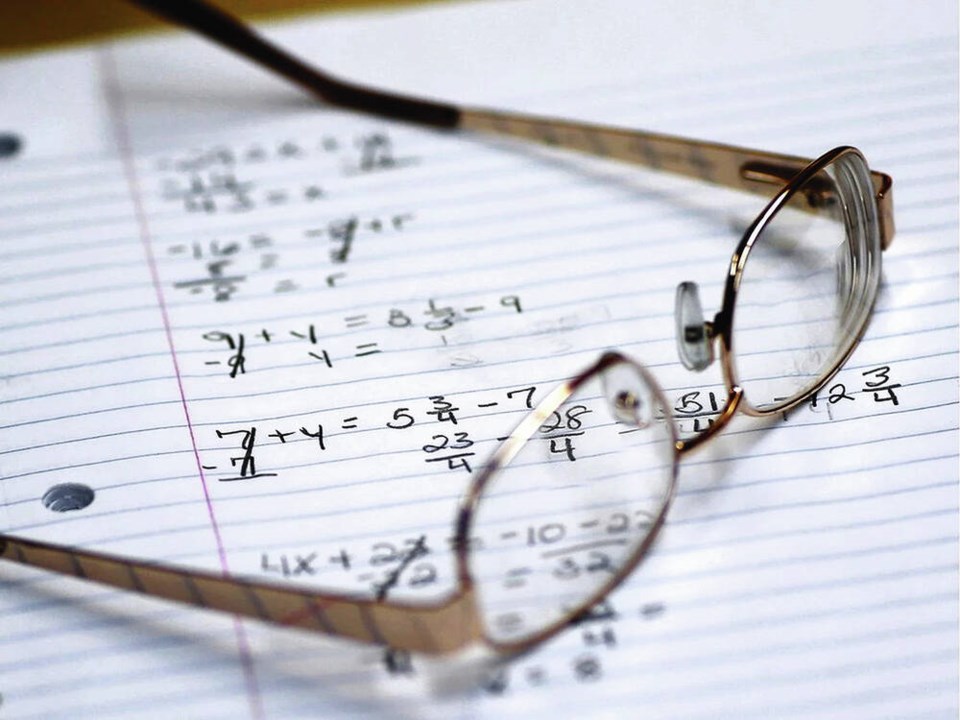A commentary by an education advocate who is the founder of WISE Math B.C. She lives in North Saanich.
Math is hard. It’s also necessary, for all levels of society, for all types of daily tasks.
It’s imperative that graduates have a strong understanding of math as they compete in an increasingly competitive global economy. And yet, in our schools, math class is treated like an afterthought.
High school students watch YouTube videos to learn pre-calculus, and instead of memorizing times tables, video games are the new way to pass the time in elementary school. Exams are a thing of the past, as are textbooks, practice sessions, and worksheets.
So how’s it going?
The latest results from the highly anticipated Program for International Student Assessment (PISA) show that British Columbia is at an all-time low — a fact that barely caused a blip on the radar screen.
Standardized assessment is used in education, as it is in medicine, law, commerce, art, and sport, to determine how these systems are working. Relying on subjective assessment isn’t enough.
In K-12 education, PISA is the gold standard for the measuring student achievement. Sponsored by the Organisation for Economic Co-operation and Development, this round had 81 countries participating.
PISA measures student achievement based on a standard set of parameters which can compare one round of assessment to the next.
Every three years, 15-year-olds worldwide are randomly selected to write PISA. This round’s focus was on mathematics. For B.C., the results were terrible.
Twenty-one per cent of British Columbia students were barely functioning at a minimum society level, compared to eight per cent in 2003.
And the smartest kids? That number has declined from 22 per cent in 2003 to 12 per cent today.
Despite prioritizing diversity and inclusion, the equity gap in our schools has increased dramatically.
A generation ago, our students were two years ahead of where they are today, at a fraction of the cost. More kids are now graduating functionally innumerate, being pushed through the system while we are paying the highest level of taxation this province has ever seen.
Provinces which acknowledged the math deficit, and made necessary changes, have seen their decline start to decelerate.
But in B.C., where our leaders support educational reforms based on meritless ideological whims, it’s like we are standing in front of a runaway downhill train, with no brakes on to slow the carnage.
Knowing that our decline was steeper than the Canadian average, the media, our political leaders, and, more importantly, our educational leaders, all stayed silent.
What is going on? Where are our democratically elected leaders and the British Columbia Teachers’ Federation, whose only job is, to ensure accountability of our children’s intellectual development? Where are the media, who should report on the injustices of our society?
It’s outrageous that individual teachers are being sanctioned for speaking out and drawing attention to this madness. If equity in the classroom were a real priority, why are parents scrambling to pay $500 to $1,000 a month for tutoring?
Media sound bites from the premier’s office claim housing is a priority. But shouldn’t the first step be to ensure that our future workers have basic math skills so they can build those houses?
The teaching of arithmetic requires patience, practice and memorization.
“Math is cumulative,” says Anna Stokke, math advocate and math professor, who has been leading the charge for proper math instruction.
“Kids need explicit instruction and lots of practice. You can’t fix a problem by doubling down on methods that don’t work. And, if you want to see what’s going wrong with math, follow the money. Lots of people making money on unhelpful professional development.”
Education faculties at B.C. universities and “educational specialists” are steering teachers away from best practices in math instruction, and our kids are paying the price.
National and provincial grassroots movements in Canada began ringing the alarm about the deplorable state of math education in K-12 schools decades ago.
Our kids struggle with math more than any other school subject, yet they are being subjected to convoluted learning strategies and poor instructional resources.
A radical rewrite of elementary math discourages memorization of times tables, and fractional arithmetic isn’t included in the curriculum until Grade 8.
We now have the weakest math standards in North America.
For all the social justice issues that have garnered 98 per cent of the educational oxygen in this province, student achievement has been ignored.
Having a basic grasp of arithmetic is the single most important social justice issue. Math, even more than reading, drives future success, and we need to ensure that children have a chance at a meaningful future post graduation.
If our provincial leaders continue to ignore the problem, parents and voters must push for publicly funded school choice alternatives.
A public system is only worth the investment if it works — but ours doesn’t.
Schools are designed to educate, not babysit, and holding those to account for failing to do their job, is long past due.



